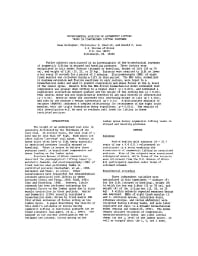Mining Publication: Biomechanical Modeling of Asymmetric Lifting Tasks in Constrained Lifting Postures
Original creation date: October 1997
Authors: S Gallagher, CA Hamrick, AC Love
NIOSHTIC2 Number: 00207997
In: Karwowski W, Wogalter MS, Dempsey PG, eds. Ergonomics and musculoskeletal disorders: research on manual materials handling, 1983-1996. Human Factors and Ergonomics Society, 1997 Oct; :86-90
A biomechanical model was used to study internal forces acting on the lumbar spine during asymmetric lifting tasks in restricted postures. Twelve healthy male subjects, nine of them experienced underground miners, participated in the study. Three independent variables were used; posture (Pos) for the lift (stooped or kneeling), height (Hgt) to which a box was lifted (35 or 70 centimeters (cm)), and weight (Wgt) of box (15, 20, or 25 kilograms (kg)). The lifting tasks were performed under a 1.2 meter roof that restricted posture. Electromyograms (EMGs) of eight trunk muscles (left and right erectores spinae, latissimus dorsi, external oblique, and rectus abdominis) were recorded during the lifting tasks and later digitized to derive a biomechanical model. The model produced estimates of muscle forces. Results showed that compression involved a significant PosxWgt interaction, and that it increased at a higher rate for kneeling than for stooping, although total compression was higher when kneeling. Lifting to a higher shelf increased compression. Peak lateral shear tended towards a nonsignificant increase in the kneeling position. Muscle recruitment was complicated due to changing conditions. Interaction of PosxHgtxWgt achieved significance at the 0.001 level. The activity of the latissimus dorsi were higher in the stooped posture than when kneeling, whereas increased erectores spinae activity was consistently seen while kneeling. The rectus abdominis muscles were slightly more active in the stooped position. The authors conclude that although the current model seems to give a good picture of the muscle loading on the spine, and will assist in the development of recommendations for lifting tasks in the mining environment, the model does not explain biomechanical factors responsible for the production of low back pain.

NIOSHTIC2 Number: 00207997
In: Karwowski W, Wogalter MS, Dempsey PG, eds. Ergonomics and musculoskeletal disorders: research on manual materials handling, 1983-1996. Human Factors and Ergonomics Society, 1997 Oct; :86-90
- A Comparison of Fatigue Failure Responses of Old Versus Middle-Aged Lumbar Motion Segments in Simulated Flexed Lifting
- Effects of Lifting in Four Restricted Postures
- The Effects of Operator Position, Pallet Orientation, and Palletizing Condition on Low Back Loads in Manual Bag Palletizing Operations
- Effects of Posture on Back Strength and Lifting Capacity
- Effects of Posture on Dynamic Back Loading During a Cable Lifting Task
- Evaluation of the Relative Importance of Coalbed Reservoir Parameters for Prediction of Methane Inflow Rates During Mining of Longwall Development Entries
- An Exploratory Study of Loading and Morphometric Factors Associated with Specific Failure Modes in Fatigue Testing of Lumbar Motion Segments
- Lifting in Stooped and Kneeling Postures: Effects on Lifting Capacity, Metabolic Cost, and Electromyography of Eight Trunk Muscles
- Physical Strength Assessment in Ergonomics
- Whole-Body Vibration and Postural Stress among Operators of Construction Equipment: A Literature Review